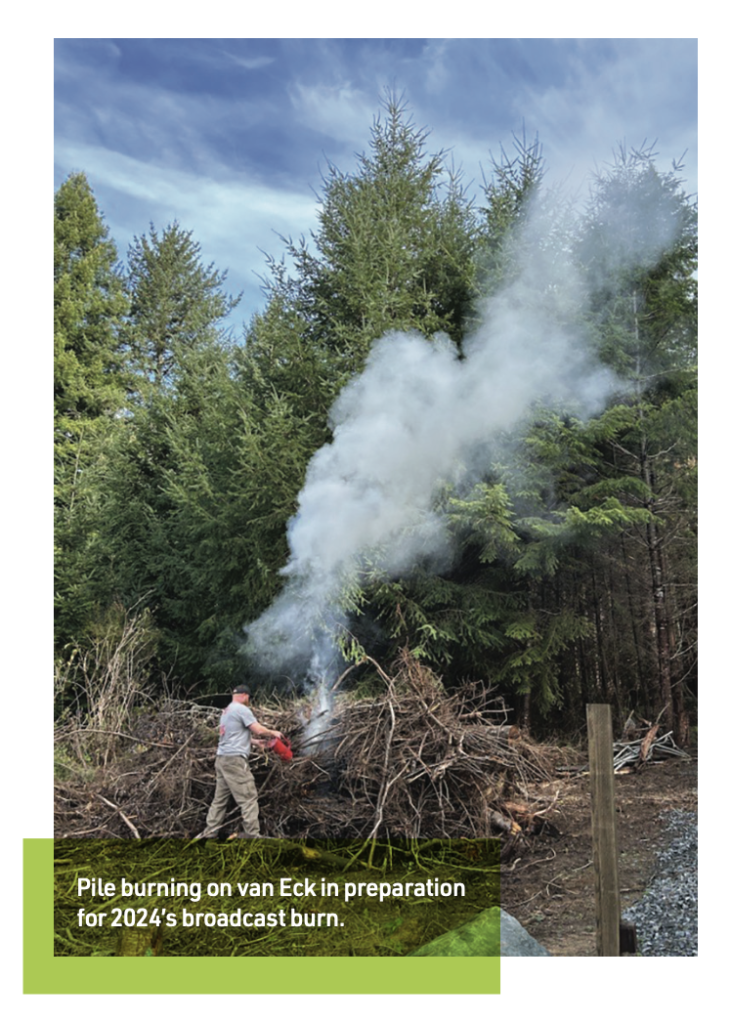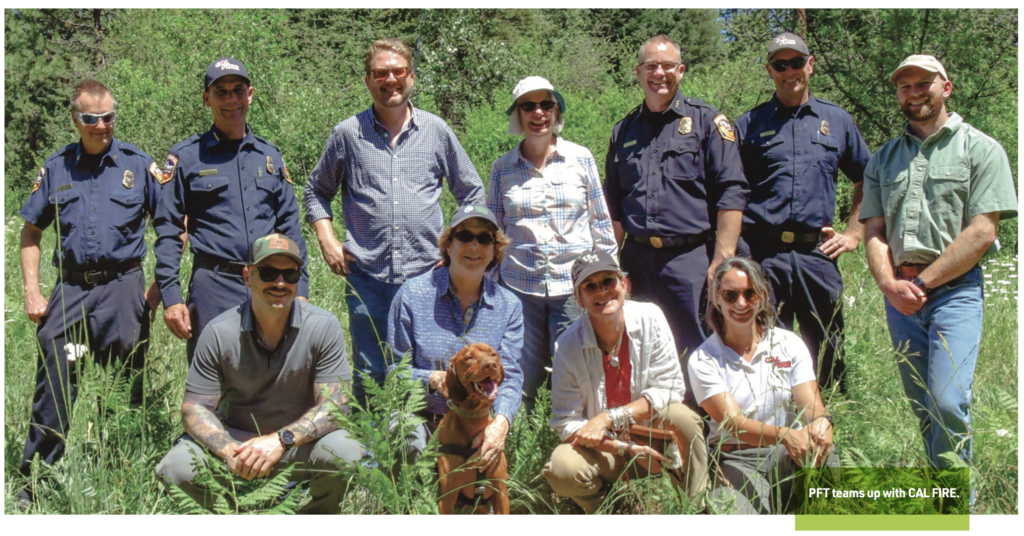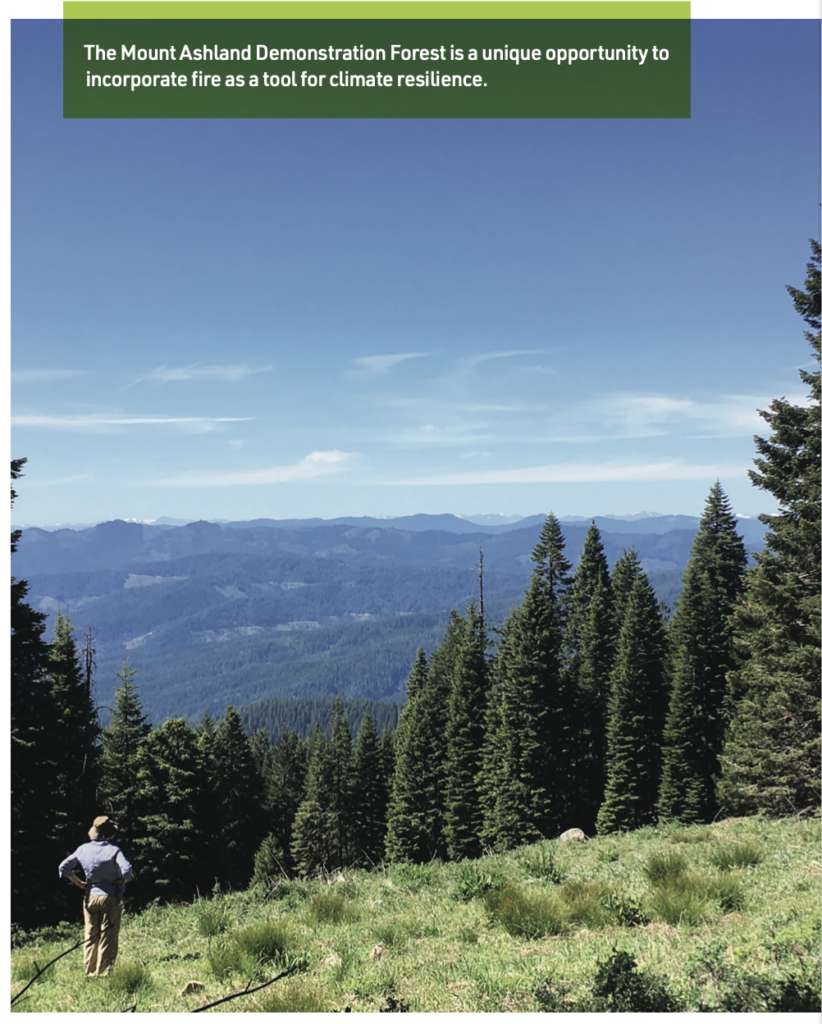
Fall 2023
Restoring Natural Fire Regimes for a Safer Future: PFT’s Fire Management
The West’s forests are naturally fire-adapted, but a century of fire suppression has inadvertently led to more fire risk rather than lowering it. Pacific Forest Trust has been at the forefront of advocating for restoration of safer, more natural fire regimes in our forests and landscapes overall, seeking to enhance community safety and forest’s resilience and ecological health.
We are now seeing a shift toward more fire management rather than suppression only. PFT’s pioneering efforts in fire span building coalitions, science-based advocacy, policy initiatives, community engagement, and now, “walking the talk” by putting “good fire” back on the landscapes we manage to help advance the art, science, and practice of managed fire in three very different landscapes.
The van Eck Forest, California

The van Eck California Forest, a 2,200-acre working redwood forest in Humboldt County, is where PFT has pioneered many new approaches to managing forests to restore their full vitality and ecological productivity. Our goal is to show how we can transform forest management from one of simplification and depletion, to one that restores natural forest diversity, function and complexity, while still earning financial returns.
From canopy restoration (see ForestLife Fall 2022) to demonstrating a new approach to meeting the goals of the Endangered Species Act to being the state’s first forest carbon-offset project, we are now adding the use of fire (pyro-silviculture) in commercial, private redwood forests. With support from the California Coastal Conservancy, we’ve developed and begun implementing a burn plan for 93 acres, with the main burn planned for next Spring. A community meeting with nearby residents and communities was held in October to explain and discuss how the burn is a key way to increase both fire safety and forest health, engaging and enlisting community support.
McCloud Soda Springs, California

The McCloud Soda Springs Working Forest spans 1,350 acres of ponderosa pine-mixed conifer forest in Northern California bordering the town of McCloud. PFT both conserved and manages these highly productive and diverse forests, which are home to numerous species as well as myriad springs
that feed into the McCloud River, world renowned for its native trout fishing. Years of industrial management and
fire suppression have altered these rich forests significantly, reduced their health and carbon stocks as well as the ability to store water in its wet meadows.
With careful restoration management to re-establish more open stands, remove small trees while favoring larger, more fire-resistant trees, PFT is now ready to reintroduce fire as a management tool. We were delighted to receive a grant of $1.8 million from California’s Wildlife Conservation Board
to conduct a large, prescribed burn—the largest on private property in the last 20 years. This burn aims to enhance the property’s fire resilience and habitat values, addressing the impacts of intense drought, intensive forest management, climate change, and fire suppression over the past century.
Mount Ashland Demonstration Forest, Oregon

The Mount Ashland Demonstration Forest, covering 1,120 acres on Oregon’s Siskiyou Crest, plays a strategic role in connecting large natural landscapes. It provides a refuge for hundreds of resident and migratory species, and links the Cascade Siskiyou National Monument to the Rogue Siskiyou National Forest. PFT’s acquisition of this property in 2021 underscored its enduring efforts to conserve the globally outstanding biodiversity of the region, creating continuous, connected, conserved corridors for wildlife on the move under climate change.
The Indigenous people of the region historically employed low-intensity, relatively frequent burning to maintain the larger forest landscape and the
many food species derived from it. Historic industrial logging changed the forest dramatically, leaving a simplified, young, and highly flammable forest as well as damaged meadows and streams. Fire suppression has led to significant fuels build up, making this forest a remarkable opportunity to demonstrate climate resilient restoration management and learn how we can safely reintroduce fire to the region. Building on the expertise of a world-class Scientific Advisory Group (see Forest Flash August 2023), PFT’s recently completed Forest Management Plan includes the reintroduction of fire in 2025, following appropriate preparations and approval by OWEB, a key funder of the Demonstration Forest.
More in this Issue of ForestLife
- President’s Letter: Endurance and Ambition
- Shasta Timberlands: Reweaving Nature’s Tapestry for Wildlife, Climate, and a Sustained Economy
- Restoring Natural Fire Regimes for a Safer Future: PFT’s FIre Management
- Donor Highlight: the Van Ecks
- From Victim to Savior? Forests and other Lands as Natural Climate Solutions
- Demonstrating a New Relationship with Fire to Benefit Forest Ecosystems and Communities
- PFT Partners with the Southern Sierra Miwuk Nation
